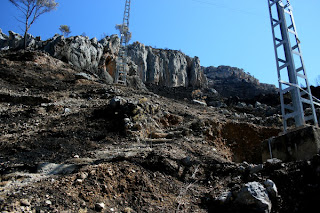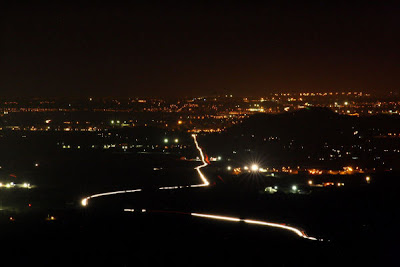Tomorrow...a Sunday.....sees local elections in two Spanish provinces; Galicia and the Basque country, who will both be voting for their regional governments. The results will be watched eagerly, not just by Mariano Rajoy, a Galician himself, but by many across Europe in the wake of yesterday's announcement by Angela Merkel that direct re-capitalisation of the (many) Spanish banks who are teetering on the brink of collapse will not happen immediately, if at all.
A worried Mariano Rajoy.
Spain is a country in crisis. To live here is to be party to the desperation of the people. Hope is now a dirty word as the nation sinks deeper into crisis and, to be honest, it's very worrying.
The Spanish are a people who do not like change and even when the rest of the world was cowering beneath the falling debris of the of the economic crisis many Spaniards were happy to ignore the signs and carry on as before. But not anymore.
Spain is changing. And it's changing rapidly. But not, I would suggest, for the better in the short-term. Things are going to get a lot worse before they start to improve.
Unemployment in Galicea is at 21% (as it happens lower than the national average) and is rising every month. Rajoy, once the local hero, is fast becoming Rajoy the embarrassment, even though he may just hang onto power in the region as a result of the popularity of the PP candidate Alberto Núñez Feijóo (below). Even so, there is expected to be a rise in the prominence of local nationalists which have a knock-on effect with further elections next month in other provinces.
Alberto Núñez Feijóo
In the Basque country the situation is more complex, with the new radical nationalist coalition, EH-Bildu expecting to gain substantial support in their push for Basque separatism. A year ago Eta, the Basque terrorist movement 'officially' renounced violence and since that time the radicals have moved towards a more political and democratic process with EH-Bildu (which actually means 'Basque country gather') blazing the way.
EH-Bildu did not take part in the 2009 elections (because they were formed after this time) and might be expected to gain considerable local influence after tomorrow elections. Polls indicate that unemployment will be the key issue in an area where the rural vote has always been majorly important. But even here it beggars belief that the radicals do not offer solutions to the problems for the electorate to mull over but instead spend their campaigning time slagging off the other parties and their mismanagement of the economy, employment, etc.
Heaven forbid that they might offer a new way of looking at things! Radical by name only it seems!
And one cannot help but wonder if, once tomorrows results are known, and the celebrations (what the Spanish do best of all!) are over, if anything will actually change.
Spain is a country in flux, but the paradox is that whilst change is being forced upon the nation by the recent austerity measures and an economy that looks to be sliding ever deeper into the red, nothing actually changes.
Everyone bitches and moans about the lack of cash in their pocket and the complete and utter absence of prospects for the current U25's, no-one really wants anything to change. If things could just go back to how they were 4 or 5 years ago then the majority of Spaniards would settle for that.
As a political and social policy, sticking one's head in the sand isn't usually a vote winner, but then Spain is a place apart, still reeling from a Francoist hangover and a black-market economy that bleeds the life from Spain as a vampire bat drains a vein, Spain is a nation lost in the political wilderness, wandering aimlessly, but forever looking over the shoulder to the good old days of a few years before.
Historically Spain has been stuck in a time-warp since the era of the Armada and as an Englishman living here I find many of the attitudes and 'customs' (for want of a better term) similarly dated, old fashioned and out-moded. On the face of it, a staunchly Catholic country, where incongruously church attendances are actually lower than in the UK, yet religious holidays hypocritically fill the calender. Any excuse for a party! And as an electoral tactic holding local elections on a Sunday is a no-brainer. It will almost certainly lower turnout because church is such a good excuse not to vote, whether you actually attend or not.
In the Basque region then the radical nationalists may well find themselves as the one of the new voices of the people. If, as expected, a similar trend is seen in Galicia with the nationalists pulling together with the communists, separatists and the ecologists, it may spark further disharmony with the Catalonian electorate who hold their elections next month. And if Artur Mas, Catalonia's President, is re-elected he has already promised a full referendum on the question of Catalonian independence, which may well be the first of many similar referendums all over Spain.
As one of Spain's richest provinces the outcome of the Catalonian referendum could be crucial for the future stability and unity of the Spanish state, especially since Mas yesterday agreed to work more closely with Basque nationalist leader Iñigo Urkullu on the issue of their respective sovereignty claims, further weakening the stance of Rajoy as he attempts to paper over the vast cracks that are fracturing this ever-more fragile and sick nation.
What the future holds here I don't know. As fast as people say 'it can't get any worse' it just does! And it keeps getting worse. I'm pessimistic about the immediate future of Spain simply because they seem to be unable to adapt to the changing economic climate. There are no new solutions for what are a host of new problems and until someone actually stands up and offers something truly radical as a possibly way out, then Spain will continue to flounder as its' people go from bad to worse.
What do you think?
P XX







































